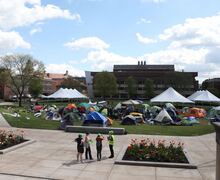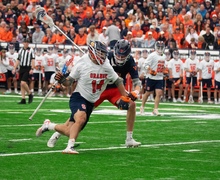Comparing SU, surrounding city serves as painful reminder of the persisting wealth gap
Daily Orange File Photo
I-81 and segregation in the city of Syracuse just steps from SU's campus show the staggering wealth disparity between the two communities.
As I walk to class it’s hard not to admire Syracuse University’s beautiful campus. Oftentimes I find myself gazing deep into the unique architecture of the Hall of Languages and the Setnor School of Music. These buildings stand out the most, due to their eerie yet intriguing visual presentation. It seems I’m not alone in admiring the campus when I see the masses of tour groups walking around campus.
It’s easy to get lost in a utopian feeling that this campus is perfect in every aspect, a bubble. Surrounding the campus, however, is a county that ranked last among the 100 largest U.S. metropolitan areas in economic growth between 2010-15, according to syracuse.com. There is a huge economic disparity within the city of Syracuse. The years of economic challenges have expanded the gap of inequality, especially when it comes to race and income.
Interstate 81 is at fault for some of this disparity. Its creation forced families to relocate, but due to housing discrimination, marginalized communities only had certain streets where they were welcomed. The condition of buildings and the racial makeup of an area in which someone lived were the two criteria for federal mortgage qualifications, according to Central NY Vitals, which discriminated against certain populations of people.
Due to this fact, many marginalized families were forced to move closer to the highway, which resulted in many problems such as higher rates of asthma from breathing in polluted air. If this wasn’t enough, I-81 literally divides lower-income residents into their own community which further perpetuates segregation.
As a result, many residents are in favor of the community grid alternative, which they think will reconnect the residents who have been alienated from one another due to the highway. A new hope seems promising because of this project.
The communities that have been separated by this highway will finally be part of one city once again. After the project is completed, this reunited community could offer more than 11,000 new jobs due to the new infrastructure and more than 30,000 for construction needs. The I-81 project is a huge step forward for a more responsive government which will ultimately improve Syracuse as a whole.
But, what does this have to do with SU? SU is one of the most expensive colleges in the U.S., located in a county ranked as the second-worst community with racial income disparities in New York state. SU seems to understand this and wants to foster the connection between the campus bubble and the community, as its website states “our office is a liaison with neighborhood, community, business, and nonprofit organizations on matters pertaining to campus-community relationships.”
SU has attempted to work hand-in-hand with the community by employing programs which promote the relationship between the campus and community. One example of this is the Connective Corridor, a bus system aimed to get students into the city more. This program allows the students to maintain a tangible relationship with the community. The school provides transportation — 200,000 rides per year — to “many great downtown activities.” Not only is this a great way for students to gain an appreciation for the new environment they’re in, but it also allows the city vendors and businesses to receive a steady stream of revenue from the campus community.
Syracuse also partners with the university for their Say Yes to Education program, which provides a great service to the Syracuse community and has set national standards of urban educational reform, which is much needed in Syracuse. It emerges young students in education in an innovative way that encourages them to reach their full potential in higher education. Many scholarships are also awarded to students with bright academic futures.
Another honorable mention is SU’s Orange Seeds, a first-year leadership program that engages in community service, such as serving food at the Syracuse Samaritan Center and working on beautification projects at the Salvation Army. The organization also plans The Big Event, the largest student-run day of community service at SU according to their website. Not only does this program teach students to become campus leaders, it also encourages them to take that leadership and use it to benefit the community they now reside in.
The students of SU are fortunate to live on a beautiful campus that provides for them. However, I call on fellow students to truly understand and appreciate this. In doing so, SU students should do more to give back to the ones who face challenges in the same city where we thrive.
Sophia Leone is a freshman broadcast, digital journalism major with a minor in political science. Her column appears biweekly. She can be reached at [email protected].
Published on February 22, 2022 at 12:45 am





